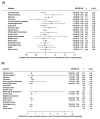This is a preprint.
Causal relationships between risk of venous thromboembolism and 18 cancers: a bidirectional Mendelian randomisation analysis
- PMID: 37292802
- PMCID: PMC10246038
- DOI: 10.1101/2023.05.16.23289792
Causal relationships between risk of venous thromboembolism and 18 cancers: a bidirectional Mendelian randomisation analysis
Update in
-
Causal relationships between risk of venous thromboembolism and 18 cancers: a bidirectional Mendelian randomization analysis.Int J Epidemiol. 2024 Feb 1;53(1):dyad170. doi: 10.1093/ije/dyad170. Int J Epidemiol. 2024. PMID: 38124529 Free PMC article.
Abstract
Background: People with cancer experience high rates of venous thromboembolism (VTE). Additionally, risk of subsequent cancer is increased in people experiencing their first VTE. The causal mechanisms underlying this association are not completely understood, and it is unknown whether VTE is itself a risk factor for cancer.
Methods: We used data from large genome-wide association study meta-analyses to perform bi-directional Mendelian randomisation analyses to estimate causal associations between genetically-proxied lifetime risk of VTE and risk of 18 different cancers.
Results: We found no conclusive evidence that genetically-proxied lifetime risk of VTE was causally associated with an increased incidence of cancer, or vice-versa. We observed an association between VTE and pancreatic cancer risk (odds ratio for pancreatic cancer 1.23 (95% confidence interval 1.08 - 1.40) per log-odds increase in risk of VTE, P = 0.002). However, sensitivity analyses revealed this association was predominantly driven by a variant proxying non-O blood group, with inadequate evidence from Mendelian randomisation to suggest a causal relationship.
Conclusions: These findings do not support the hypothesis that genetically-proxied lifetime risk of VTE is a cause of cancer. Existing observational epidemiological associations between VTE and cancer are therefore more likely to be driven by pathophysiological changes which occur in the setting of active cancer and anti-cancer treatments. Further work is required to explore and synthesise evidence for these mechanisms.
Keywords: Mendelian randomisation; deep vein thrombosis; genetic epidemiology; malignancy; pulmonary embolus.
Conflict of interest statement
Conflict of interest Robert C Grant is an Advisory or Honoraria for Astrazeneca, Eisai and Knight Therapeutics and is in receipt of a Graduate Scholarship from Pfizer. No other conflicts of interest declared.
Figures




References
-
- Wendelboe AM, Raskob GE. Global Burden of Thrombosis: Epidemiologic Aspects. Circ Res 2016;118:1340–7. - PubMed
-
- Timp JF, Braekkan SK, Versteeg HH et al. Epidemiology of cancer-associated venous thrombosis. Blood 2013;122:1712–23. - PubMed
-
- Sørensen HT, Mellemkjær L, Steffensen FH et al. The Risk of a Diagnosis of Cancer after Primary Deep Venous Thrombosis or Pulmonary Embolism. N Engl J Med 1998;338:1169–73. - PubMed
Publication types
LinkOut - more resources
Full Text Sources
